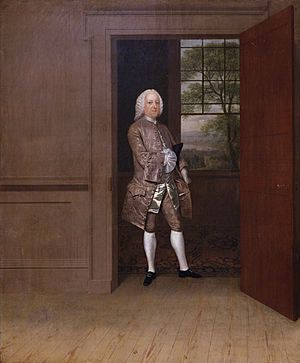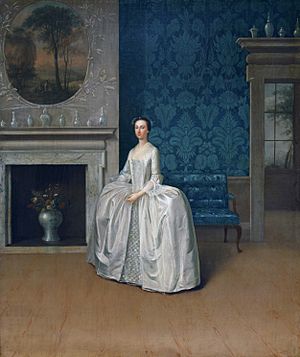Thomas Penn facts for kids
Quick facts for kids
Thomas Penn
|
|
|---|---|

Thomas Penn depicted in a 1752 portrait
|
|
| Chief proprietor of Pennsylvania | |
| In office 1746–1775 |
|
| Monarch | George II (1746–1760) George III (1760–1775) |
| Preceded by | John Penn |
| Succeeded by | John Penn |
| Personal details | |
| Born | 8 March 1702 Kensington, London, Kingdom of Great Britain |
| Died | 21 March 1775 (aged 73) Stoke Poges, Buckinghamshire, Kingdom of Great Britain |
| Spouse | Lady Juliana Fermor Penn (m. 1751) |
| Children | 8, including Granville |
| Parents | William Penn Hannah Callowhill Penn |
| Profession | Landowner, mercer |
Thomas Penn (born March 8, 1702 – died March 21, 1775) was an English landowner. He was the main owner, or chief proprietor, of the Province of Pennsylvania from 1746 to 1775. He was one of 17 children of William Penn, who founded Pennsylvania in America.
In 1737, Thomas Penn was involved in a deal called the Walking Purchase. This was a land agreement with Lenape chief Lappawinsoe. It gave Pennsylvania control over a huge area of land, about 1.2 million acres. This land is now in parts of Pennsylvania and New Jersey.
Thomas Penn was born in 1702 in Kensington, England. His family, the Penns, were Quakers. Because his family didn't have much money, his father, William, arranged for Thomas to train as a mercer (a fabric seller) in London.
When his father died in 1718, William's will gave ownership of Pennsylvania to his three sons, including Thomas. In 1732, Thomas Penn traveled to Pennsylvania. He went there to manage his family's land and collect money owed to them.
His family in England was deep in debt. So, Thomas Penn changed his father's friendly way of dealing with Native American tribes. He wanted to get more land to sell. He signed treaties with Native American leaders. He also made the deputy governor more powerful. He often changed laws made by the Pennsylvania General Assembly. These actions made him unpopular in the colony.
Penn went back to England in 1741. But he still controlled what happened in Pennsylvania. When his brother John died in 1746, Thomas became the chief proprietor. In 1751, he married Lady Juliana Fermor. They had seven children together. Thomas Penn died at his home in Stoke Park, Buckinghamshire in 1775.
Contents
Early Life and Family Beginnings
Thomas Penn was born on March 8, 1702, in London, England. His father was William Penn. William was a Quaker who founded the Province of Pennsylvania in 1681. He received a special charter, or permission, from King Charles II. Thomas's mother was Hannah Callowhill Penn. She married William on March 5, 1696. Before Thomas was born, his parents lived in Pennsylvania from 1682 to 1701. They lived at Pennsbury Manor in what is now Bucks County, Pennsylvania.
Even though William Penn owned Pennsylvania, his family didn't get much money from the colony. To help his family, Thomas's father arranged for him to become a mercer. This meant he learned to sell fabrics and textiles in London. He was part of a group called the Worshipful Company of Mercers.
When William Penn died in 1718, his will divided the ownership of Pennsylvania. It went to Thomas and his brothers, John and Richard. In 1727, a court in Britain confirmed William's will. Four years later, the children from William's first marriage agreed to a settlement. The original agreement from King Charles II said the Penn family owned all the land and mining rights in Pennsylvania. In return, they had to send two beaver skins to Windsor Castle every year. However, owning the colony did not guarantee they would be rich.
Managing Pennsylvania's Affairs
Thomas Penn took charge of his family's money matters. In 1732, he traveled to the Province of Pennsylvania. He was the first Penn family member to visit the colony since his father left in 1701. When he arrived, the colonists generally welcomed him. His main goals were to collect unpaid rents from settlers. He also wanted to get payments for land already settled. Another goal was to protect the Pennsylvania frontier from attacks. These attacks could come from Native American tribes or nearby French colonies.
In May 1734, Thomas's brothers, John and Richard, wrote to him from England. They told him the family owed 8,000 pounds. They urgently needed money from the colony. They said it was "absolutely necessary" to make a profit from Pennsylvania. They even suggested selling the colony if Thomas couldn't make money. They felt they were "at the Mercy of our creditors."
Because of these money problems, Thomas Penn changed his approach. His father had been friendly in talks with Native American tribes. Thomas became more aggressive. He wanted to get more land for colonial settlers. He worked with the royal governor of Pennsylvania, James Logan. They planned to get more land from the Lenape tribe. More people were moving to the colony. Also, there were worries that settlers from Province of New York were moving into Pennsylvania's northern areas.
In 1737, Thomas Penn and James Logan negotiated the Walking Purchase treaty. They made this agreement with Lenape chief Lappawinsoe. The treaty said that an older 1686 agreement gave Pennsylvania 1.2 million acres of land. This land was along the northern part of the Delaware River. After the treaty, the Lenape moved out of their villages in that area. Historians like Steven Grant Harper say that Penn and Logan used a misleading map. They believe the treaty was not fair to the Lenape.
Penn also played a big role in the colony's daily business. Even though he was the owner, a deputy governor usually ran things. Thomas Penn worked to give the deputy governor more power. This helped his family keep more control in Pennsylvania. In 1741, Penn returned to England. He left the colony in the hands of deputy governor George Thomas. By this time, many colonists thought Thomas Penn was "greedy and cold."
Life After Returning to England
After Thomas Penn went back to England, his brother John died in 1746. In his will, John gave his share of Pennsylvania's ownership to Thomas. This made Thomas the main owner of Pennsylvania. He continued to be involved in the colony's matters. For example, he tried to make the Lenape follow European land rules. He set aside land near the Lehigh River as an "Indian Manor." This land was only for the tribe.
In 1755, the Lenape living in the "Indian Manor" moved west. This was because of the French and Indian War and growing tensions with European settlers. Thomas Penn heard about this from his employee in Pennsylvania, Richard Peters. Penn told Peters to rent out the land. He said there was "no probability of the Indians coming back to the Indian Manor."
In 1757, Benjamin Franklin was sent to England by the Pennsylvania General Assembly. He was a colonial agent who wanted to complain about the Penn family's power to the British government. Thomas Penn watched Franklin closely. But he wasn't worried about losing his ownership. Penn knew Franklin didn't have many friends in the British government. Franklin's mission eventually failed.
The Seven Years' War (1754–1763) showed how hard it was to manage the family's American lands from England. In 1763, Thomas's nephew, John, became the deputy governor of Pennsylvania. John often wrote to Thomas about issues in Pennsylvania. As Thomas Penn's health got worse, John took on more responsibility for managing the colony.
Personal Life and Family
On August 22, 1751, Thomas Penn married Lady Juliana Fermor. She was the daughter of Thomas Fermor, 1st Earl of Pomfret. Juliana was 22 years old, and Thomas was 27 years older than her. A year after they married, Penn asked painter Arthur Devis to paint portraits of him and his wife.
Thomas Penn was born into a Quaker family. However, over time, he slowly stopped following some Quaker beliefs. His marriage to Juliana in a Church of England church confirmed his move away from the Quaker faith.
Thomas and Juliana had seven children during their marriage. They had four sons and three daughters. One of their sons, John, later served as the High Sheriff of Buckinghamshire in 1798. He was also a member of parliament in the British House of Commons. Another son, Granville, was a writer. Thomas Penn bought a large country house called Stoke Park, Buckinghamshire in 1760. His son John later made it much bigger with designs from architect James Wyatt.
Death and Legacy
Thomas Penn died on March 21, 1775, at his home in Stoke Poges, Buckinghamshire. In his will, he left his share of Pennsylvania's ownership to his son, John. John was the last family member to own Pennsylvania. The government of Pennsylvania officially ended the family's ownership after the American War of Independence started in 1776. The Penn family was owed a lot of money and land. As payment, the Pennsylvania government gave them £130,000.
In Pennsylvania, many people felt angry and disliked Thomas Penn. This was very different from how they felt about his father. In 1757, Benjamin Franklin wrote that Thomas Penn refused to pay taxes to Pennsylvania. Franklin said this made him feel "more cordial and thorough Contempt [towards] him than I ever before felt for any Man living." Besides not paying taxes, Penn often used his power to change laws passed by the General Assembly. Some historians believe this helped lead to Pennsylvania supporting the American Revolution.
The Walking Purchase Lawsuit
In the early 2000s, Thomas Penn's role in the Walking Purchase became a big issue for the Lenape people. In 2004, the Delaware Tribe of Western Oklahoma filed a lawsuit. They sued the Commonwealth of Pennsylvania in a US court. The Delaware Tribe wanted 314 acres of land from the Walking Purchase. They said the original deal between Penn and the Lenape was unfair. The court decided to dismiss the case, meaning it was stopped. A higher court also agreed with this decision in 2006.


